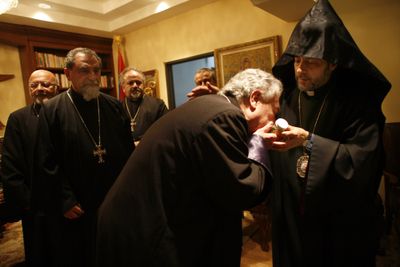Special delivery
Modern obstacles don’t stop flow of ancient holy oil

Every seven years since A.D. 301, priests have trekked to the ancient Cathedral of Etchmiadzin in Armenia to retrieve freshly brewed muron – a sweet-scented holy oil stirred with what is said to be the tip of the lance driven through Jesus’ side – and carry it back to their respective dioceses.
Prepared in a massive silver caldron, the mixture of herbs, flower extracts, spices, wine and pure olive oil is derived from an original batch mixed at the Armenian Church’s founding 1,707 years ago. It is replenished every seven years by pouring old into new, continuing a mysterious connection between distant generations.
The priests traditionally have traveled home with their portions in jars cradled in their arms, because muron is supposed to be handled only by ordained clergy.
That all changed late in September when ancient tradition met with a 21st-century obstacle put in place since the last trip for the holy oil: As a liquid, muron cannot be taken aboard commercial airliners, according to airport security rules.
“We were very worried – in the old days, we carried the muron in our hands,” said His Eminence Archbishop Hovnan Derderian, primate of the Western Diocese of the Armenian Church of North America, which is based in Burbank, Calif. “I would never have given away that privilege, but we had no option.”
Derderian bundled up his six containers in layers of cloth and then packed them snugly into three suitcases. Airport baggage handlers took it from there.
“I was confident that nothing would happen to it,” he said. “You do your best, and then trust in God.”
Derderian’s containers arrived safely after a 20-hour flight.
A genial man with a black beard, Derderian declared mission accomplished Oct. 7 when priests from churches across Southern California gathered around a massive oak table in his office.
Their 7-ounce portions of the amber-hued oil were presented on a silver tray: 15 small glass jars with white screw-cap lids, each one marked with a label written in English and Armenian: “Holy Muron. Sept. 28, 2008. Holy Etchmiadzin.”
After prayers and solemn hymns, the clergy, clad in black robes, stood and formed a line. Fist-sized silver crosses – some studded with precious stones – dangled from silver chains around their necks. They approached the table, in turn, with heads bowed and kissed the jars that Derderian placed in their hands.
A few minutes later, they were heading back to their churches, where the oil would be transferred into dove-shaped sterling silver containers symbolizing the Holy Spirit.
Over the next seven years, the muron will be used – a few drops at a time – primarily for christenings in Armenian churches the world over.
Muron’s origins date to the founding of the Armenian Church, which was established in the early fourth century by St. Gregory the Illuminator, patron saint of Armenians. He established the Cathedral of Etchmiadzin, one of the world’s oldest cathedrals.
St. Gregory is said to have blended the first muron there as a unifying religious symbol of forgiveness and peace, and as a medicine for healing.
Over the centuries, church leaders say, muron helped sustain a people decimated and dispersed by war, conquest and genocide.
This muron season, more than 70,000 people braved drenching rains to watch His Holiness Karekin II, supreme patriarch and catholicos of Armenians worldwide, lead a procession from the Cathedral of Etchmiadzin to an outdoor altar where the mixture had been steam-heated for 40 days and nights.
The ceremony culminated with a pitcher of fresh muron being combined with the old in a gigantic engraved silver caldron and stirred with an assortment of religious relics: a cross believed to contain a fragment of the wooden cross on which Jesus was crucified; a foot-long iron tip of the lance believed to have pierced Jesus’ side, and a life-size gold-plated “Right Arm of St. Gregory the Illuminator” said to be embedded with a fragment taken from St. Gregory’s grave.